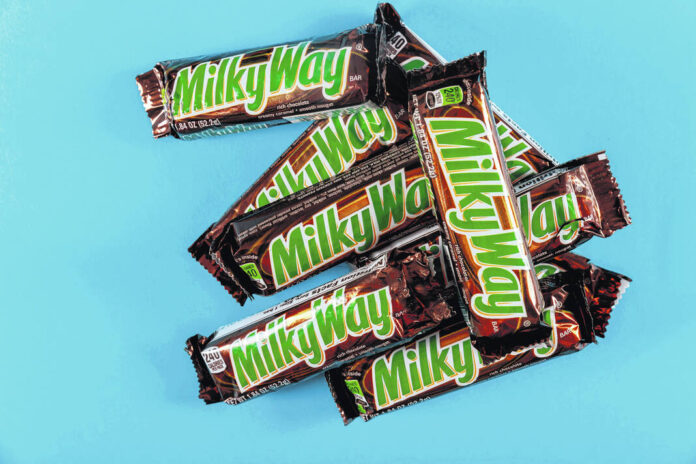MINNEAPOLIS — Frank Mars needed a breakthrough.
The Minnesota candyman was having limited success with his Mar-O-Bar. The chocolate-coated whipped cream confection was too fragile to travel far and looked destined to join previous failures.
As he sat with his son Forrest at a Minneapolis diner, the younger Mars had an idea that would change their lives — and candy — forever: Why not make a candy bar version of a malted milkshake?
One hundred years ago, in 1923, the first Milky Way bar was made and sold in Minneapolis. Within a year, sales reached $800,000 — the equivalent of more than $14 million in today’s dollars.
Not bad for a 5-cent candy bar — which, to be clear, was named after the popular milkshakes of the time, not the galaxy.
“Malted milk, caramel and chocolate were very important to young people during the day,” said David Borghesani, chocolate historian at Mars Wrigley. “He launches this bar and starts advertising a chocolate malted milk in a candy bar. He’s making that connection with consumers.”
From a warehouse on Washington Avenue dubbed the “Nougat House,” the company that became Mars Inc. quickly grew to employ hundreds. Advertising campaigns and a national sales force got the word out about the newfangled confection of fluffy nougat, caramel and chocolate.
“He’s very ahead of his time and understands the importance of advertising,” Borghesani said.
While the company would leave for Chicago by the end of the decade and is now based in Virginia, the success of the Minnesota-born Milky Way would lead to other long-lasting hits like Snickers, Three Musketeers and M&M’s, making the Mars family billionaires in the process.
Today Mars is the fourth-largest private company in the U.S. with annual revenue of more than $45 billion, according to Forbes.
“We hold Milky Way in high esteem,” said Anton Vincent, CEO of Mars Wrigley North America. “The people that preceded me many years ago had an eye on the future and ensured that we had a place in people’s lives.”
In the kitchen with his mom
Franklin Clarence Mars was born in western Minnesota in 1883, according to official company history.
As a child, Mars suffered a bout of polio and spent time in the kitchen with his mother, Elva, learning to hand-dip chocolate candy. By 1902, when he was 19, Mars was selling toffee chips across rural Minnesota and married his first wife, Ethel.
They welcomed Forrest Edward Mars into the family in 1904.
In 1910 the couple divorced, and Mars married another woman named Ethel. In 1911 they moved to Tacoma, Washington, to start wholesaling hand-dipped butter cremes.
“That’s the year we say Mars was actually founded, 1911, when Mr. Mars digs into this business,” Borghesani said. “This is fun, but he thinks he can do better.”
In 1920 the family moves to Minneapolis. Mars introduces a chocolate candy, Patricia Chocolates, named after his daughter. Then comes the Mar-O-Bar, which failed to reach Mars’ goal of $100,000 in sales despite the ad campaigns:
“Just like whipped cream covered with milk chocolate — everybody likes ‘em.”
After 20 years of struggling to conquer America’s sweet tooth, Mars finally finds his long-sought success when his son pitches the idea of a chocolate malted milk in a candy bar.
That was shortly after Frank had to bail his son out of jail in Chicago. Forrest had been arrested after he plastered Camel cigarette posters all over the city as part of a sales campaign, he would later recount.
Who’d-a thought it?
The Milky Way was introduced and sold locally the first year, then went into full production in 1924.
“It’s a nougat bar, which made him very different from the competition, layered with caramel then enrobed in chocolate,” Borghesani said.
That mechanical enrobing was key to the Milky Way’s success — it coated the sides of the bar evenly and advanced the industry beyond time-consuming hand-dipped chocolates.
Similarly, it was a technological breakthrough that gave Milton Hershey the ability to scale his dreams into the first national chocolate empire decades earlier. Hershey would become a key chocolate supplier for Mars before the companies became bitter rivals, in part due to the success of the Milky Way and the threat it posed to Hershey bars.
Mars dispatched sales teams to cities around the country — a 1925 Minneapolis Journal ad sought “detail men to sell Milky Ways.”
“Lima will be campaigned this week by a crew of eight young men advertising the famous Milky Way candy bar,” the News and Times-Democrat of Lima, Ohio, reported in 1925.
By the end of the decade, sales had grown to $26 million — almost half a billion in today’s dollars — and the dark chocolate and vanilla nougat bar that would become Milky Way Midnight was seeing early success.
Having outgrown the warehouse on Washington Avenue, Mars Inc. built a factory in Chicago and moved its headquarters there in 1929.
The company announced just last year it would be closing that Chicago plant.







